Part I – Best Talent in Years

Harry Stuhldreher
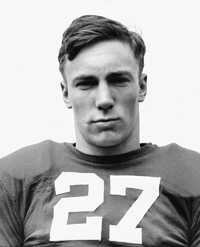
Dave Schreiner
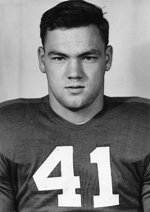
Mark Hoskins
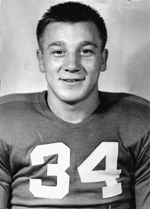
Pat Harder
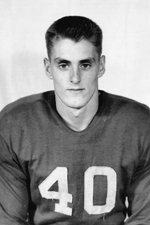
Elroy Hirsch
|
Harry Stuhldreher looked forward to the 1942 season, his seventh as head coach at Wisconsin. The 5'7" 151 lb QB of Knute Rockne's famed Four Horsemen of Notre Dame, had compiled a mediocre 19-27-2 record in Madison. Since he was also the AD, his job was not in jeopardy. However, he had reason to think the first season after Pearl Harbor would be by far his best.
- Since freshmen were ineligible to play varsity ball, they served as the "scout" team for the varsity, running the plays of the next opponent at practice. Many universities also scheduled a set of games with other freshmen squads, usually on Fridays.
- The 1939 Badger freshman squad had produced several fine players, including E Dave Schreiner, who broke into the starting lineup as a sophomore, and HB Mark Hoskins, who threw a key TD pass to Schreiner in a victory over Marquette in 1940. Schreiner had made All-American in 1941 as a junior.
- The next freshman class included FB Pat "Hit 'em Again" Harder, who became the Big Ten's leading rusher and scorer in 1941 as a sophomore.
- The 1941 freshman crop was even more exceptional, led by HB Elroy Hirsch and C Fred Negus. This group regularly outplayed the varsity in scrimmages.
During spring practice a few months after the Japanese attack on Pearl Harbor, Stuhldreher told his players to stay in school and enlist in the reserves. When informed that the Marines planned a unit for underclassmen on the Wisconsin campus and that the Marine officers-in-training could play football, Harry instructed his players to join the Marine program. In this way, they could play at least the 1942 football season before fulfilling their military obligations.
Stuhldreher still ran the "Notre Dame Box" formation that he learned from Rockne despite the fact that more and more teams were switching at least part of the time to the T formation. Harry relished the prospect of Hirsch, operating as the TB, running behind the blocking of FB Harder. Although he was a Wisconsin boy, from Wausau, Hirsch had leaned toward Bernie Bierman's Minnesota Golden Gophers, undefeated national champions in 1940, until a group of hometown businessmen promised to pay his tuition and room and board at Madison. An outstanding runner, Hirsch was only an average passer. Harry did install a few T formation plays for the '42 season to take advantage of a young passer named Bud Seelinger from Wyoming.
The Badgers reported for preseason workouts on September 1, three weeks before the start of the fall term. The squad consisted of 54 players, 20 of whom would play on the B squad in a limited schedule. In the first scrimmage, Harder suffered a severe bone bruise on his leg, the start of a string of injuries that would plague him all fall. He and Hirsch were being touted as the "H Boys" who could lead the Badgers to their best season since the 1928 team went 7-1-1.
The schedule included 10 games for the first time since 1905. The first five were out-of-conference contests against Camp Grant, Notre Dame, Marquette, Missouri, and Great Lakes Naval Air Station. The last five foes all represented the Western Conference (or Big Nine as it became when Chicago dropped out after the 1938 season): Purdue, Ohio State, Iowa, Northwestern, and Minnesota.
Game One: September 19
Camp Grant came from Chicago to open the 25th anniversary year of Camp Randall Stadium, located on land that had been a Civil War training camp 80 years earlier. With travel restrictions in effect during the war, only 15,000 watched the Badgers score a lackluster 7-0 victory. Harder did nothing except kick. After Seelinger started at LHB, Hirsch came in to gain 88y, including runs of 25 and 50. The backup FB, Bob Ray, scored the only TD on a 12y run on the first play of Q4. Fans left wondering how good their team really was if they couldn't beat an out-of-shape military team more convincingly.
It wouldn't take long to find out how improved the Badgers were. Mighty Notre Dame was coming to town.
|
|
Part II – Irish Come Calling
Harry Stuhldreher idolized Knute Rockne, his coach at Notre Dame, and tried to implement his football program at Wisconsin. Now Harry's alma mater was coming to Madison, led by another former Rockne player, Frank Leahy, in his second season since moving from Boston College. Frank had led the Irish to an 8-0-1 record in 1941. Now he had installed the innovative T formation for the '42 season. Since this was ND's first game of new season, the Badger staff had no scouting report. To say that Stuhldreher wanted to beat his alma mater and show that he, not Leahy, ran the quintessential Rockne program, would be an understatement.
Wisconsin held a pep rally the night before the game. Bill Stern, the most famous sportscaster in the country, was in town to do NBC's national broadcast. He told the fans at the rally, "If you win, I'll be back." Meanwhile, Notre Dame spent the night in Chicago before taking a train to Madison Saturday morning. However, when the team boarded, QB Angelo Bertelli, the main reason Leahy had installed the T, was missing. When the team arrived at Camp Randall Stadium just ninety minutes before the 2 pm kickoff, Leahy called back to the hotel, the train stations, and the police trying to find his star. As his squad warmed up before the game, Leahy prepared his second string QB to start. Finally, five minutes before kickoff, Bertelli ran onto the field. He had gotten lost in Union Station and barely caught another train to Madison.
Game Two: September 26
Because of wartime travel restrictions, only 32,000 attended. They saw a scoreless game until Q3 when Pat Harder returned a Bertelli punt to the ND 35. Elroy Hirsch then bolted around RE and down the sidelines for a TD. Harder's kick made the score 7-0. Later in the period, Bertelli completed passes of 20 and 17 yards to set up Jim Mello's plunge from the 2. Bertelli toed the tying point. After those two bursts of offensive excitement, the game reverted to trench warfare. Neither team threatened again, and the game ended in a deadlock. The visitors dominated the stats with 292y to 152 and led in first downs 14-7. Six turnovers cancelled ND's numerical edge. Bertelli showed the effects of his late arrival scare as he connected on only four of 13 passes for 66y. Leahy was immediately criticized for installing the T. As was typical of football in those days when the rules limited substitutions, Stuhldreher used only 16 men. Six players never sat out even one play. The Badgers had caught the attention of the nation as a legitimate Big Ten contender.
Game Three: October 3
The Badgers played their third straight home contest, hosting Marquette from Milwaukee before 35,000. UW won easily 35-7, exploding for 28 points in Q2. All-American E Dave Schreiner caught three TD passes, 70 and 22y from QB Jack Wink and 13 from FB Harder. The other TD in the second stanza came on Hirsch's 20y scamper on which he shed two tacklers and carried another across the goal. Elroy threw a 41y TD in Q3 to Bob Hanzlik to complete the Badger scoring.
Game Four: October 10
Missouri came to Madison 3-0 having just topped off Colorado 26-13. Coach Don Faurot was considered an innovative offensive coach, pioneering the split-T formation. The game was broadcast on a local Madison radio station and transmitted to U.S. forces in Alaska and the Pacific Saturday night on tape. Before the game, the new campus WAVES unit marched into the stadium in formation. The young women wore civilian clothes since their uniforms had not arrived yet. 25,000 applauded them vigorously, then settled down to enjoy another fine performance by Hirsch. He gained 174 on 22 carries and completed an 18y pass to Schreiner, one of only two UWcompletions. Elroy gave the crowd what they came to see in Q1 with a 20y run on which he stiff-armed a tackler at the 10, then crashed through two others to pay dirt. He added a 7y TD run later to spark the 17-9 triumph. This time 31 Badgers saw action. The bad news was that Harder suffered still another injury, a knee strain late in Q1.
The Badgers moved to 4-0-1 with one more home game before finally hitting the road to start conference play.
|
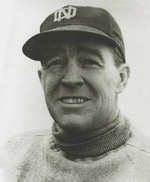
Frank Leahy
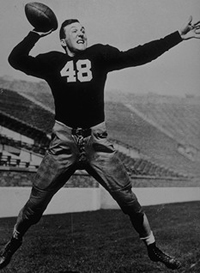
Angelo Bertelli
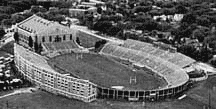
Camp Randall Stadium
in a 1947 photo
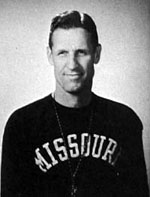
Don Faurot
|
|
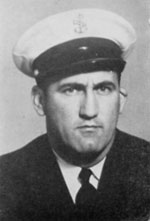
Steve Belichick
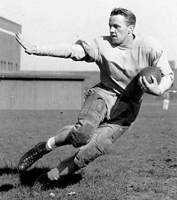
Bruce Smith
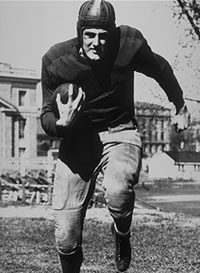
Elroy "Ghost" Hirsch
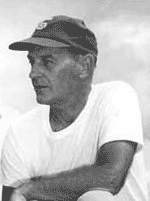
Paul Brown
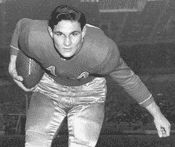
Gene Fekete
|
With the 3-0-1 Badgers, ranked #7 in the first AP poll of the season, preparing for their first road game of the season, President Franklin Roosevelt urged Congress on October 12 to lower the draft age from 20 to 18. This would mean that college football recruits would not have two years of college before being drafted but would have to report to the military right out of high school. Two days later, All-American E Dave Shreiner, representing the team, presented Coach Stuhldreher with a war bond for his 41st birthday.
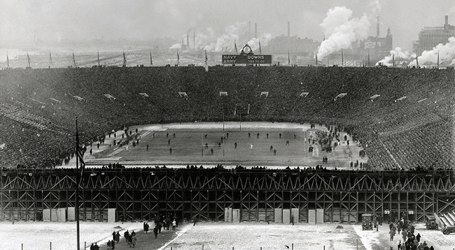
Soldier Field, Chicago
Game Five: October 17
Wisconsin met the Great Lakes Naval Air Station team at mammoth Soldier Field in Chicago. Great Lakes, coached by Tony Hinkle, the long-time basketball coach at Butler University, had defeated Iowa and Pittsburgh but lost to Michigan. Many of the players on the Bluejackets team were instructors in the recruit training division.
- Steve Belichick, former player for Western Reserve and the Detroit Lions and future father of NFL coach Bill Belichick
- RB Bruce Smith, the reigning Heisman Trophy winner from Minnesota who had a field day in the final game of 1941 against UW
- Howard "Red" Hickey, Cleveland Rams receiver
- Carl Mulleneaux, Green Bay Packers E
- Bill Radovich, Detroit Lions G
- Hugh McCullough, Chicago Cardinals HB
Wisconsin students thinking about attending the game were promised a free beer at a local tavern before leaving and told that they could get into the stadium for only 80 cents with a coupon book. The team was housed Friday and Saturday nights at the plush Palmer House Hotel in downtown Chicago.
Only half of the 60,000 who attended paid since soldiers in uniforms were admitted free. Great Lakes led 7-0 at the half, thanks to a 65y TD pass from Smith to ex-Nebraska star Fred Preston. However, Hirsch tied it in Q3 with a 61y run that Willard Smith of the Chicago Tribune described as "twisting and squirming perilously close to the sideline ..." Francis Powers of the Chicago Daily News wrote that Hirsch's "crazy legs were gyrating in six different directions all at the same time." Although Elroy was called "Ghost" the rest of the season, the "Crazy Legs" moniker later gained the advantage.
Later in Q3, Smith threw a long pass for Mulleneaux just across the goal line. However, QB Jack Wink cut in front of him for a one-handed INT which he ran back 101y for the go-ahead TD. Harder's PAT went wide. However, the rest of the game was scoreless and the Badgers went home a 13-7 victor. Wisconsin had already surpassed its victory total for all of 1941 as it entered Big Ten play for the rest of the season.
Game Six: October 24
Stuhldreher, like most coaches, always glorified the next opponent and the 1-3 Purdue Boilermakers were no exception. He particularly praised the Boilers' RB Hank Stram, future Super Bowl-winning coach of the Kansas City Chiefs.
The Badgers spoiled Purdue's homecoming before 19,500 fans at Ross-Ade Stadium. Pat Harder returned to action to gain 99y on 25 carries. Hirsch contributed 50 on 12 tries, including a 26y run that set up Harder's 4y TD that broke the scoreless tie in Q2. Stram was restricted to 10y on six carries in the 13-0 loss. The Badgers rose to #6 in the AP poll.
Game Seven: October 31
UW looked forward to returning home after two weeks on the road. Especially since the opponent was #1 Ohio State which had defeated the Badgers 46-34 in 1941 in Paul Brown's first season at the helm in Columbus. Adding to the drama – but unknown at the time to the public and the media but understood by the Badger squad – was the jealousy that Stuhldreher felt toward Brown. Both had played for Massillon High. When Brown was an MHS Tiger, his idol was Four Horseman Stuhldreher. Returning later to coach Massillon, Brown won six consecutive state championships to replace Stuhldreher as the city's favorite football son. In addition, Harry felt that Brown lucked into the Ohio State job, which, after Notre Dame, was Harry's dream gig.
The Friday night pep rally attracted 8,000. When it broke up, thousands of students marched down Madison's main street, "blocking traffic, rocking cars and trampling everything in their path" (according to the UW Daily Cardinal). The State-Journal called it a "three-hour riot." Even the Buckeyes, who had arrived earlier in the day, were caught in the mayhem, some breathing in tear gas before retreating to their hotel, where many of the players were kept up most of the night by the bedlam. However, the disturbance was not OSU's main problem. Many players were ill from the water they had drunk on the ancient train they had taken from Columbus because the military got priority on the newer equipment.
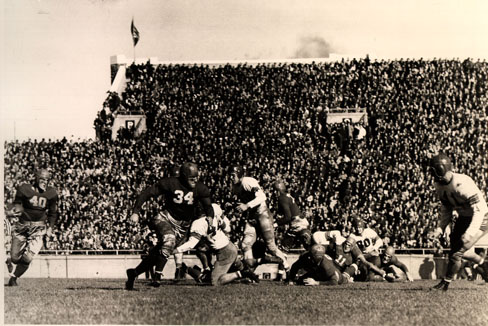
HB Hirsch (40) running behind FB Harder (34) against Ohio State
As a result of their dysentery problems, the Buckeye starters didn't take the field until eight minutes before the 2pm kickoff of the game nationally broadcast on NBC by Bill Stern. On Wisconsin's third possession in a scoreless game, Hirsch followed Harder's crushing block for 59y to the OSU 21. A few plays later, Harder plunged over from the 1 and kicked the EP for a 7-0 lead. With the D stifling Brown's potent O, the Badgers took a 10-0 lead into halftime after a 37y Harder FG.
During the homecoming festivities, part of the Badger band started to spell out script OHIO in imitation of the Buckeye band's famous maneuver. Incredulous UW fans booed until they saw the rest of the band form a tank and flatten the Ohio formation before the I could be dotted. In a scene repeated all over the nation that season, tribute was paid to former Wisconsin students serving in the Marines, Army, and Navy.
Early in Q3, OSU marched 96y for a TD to pull to 10-7. FB Gene Fekete, Harder's main competition for All Big Ten FB, scored from the 4. However, Wisconsin didn't crack. Hirsch's passing sparked the clinching drive as he first hit Schreiner for 12, then floated another to his star E in the EZ from the 14y score to make the final score 17-7. Wisconsin had defeated Ohio State for the first time since 1918! Furthermore, the Badgers were now the only team undefeated in conference play.
|
|
The 6-0-1 Badgers, all alone in first place in the Big Ten and now ranked #2 in the AP poll, had three more games left, all in the conference. After trips to Iowa and Northwestern, Wisconsin would host its archrival Minnesota.
Game Eight: November 7
Because the military had first call on buses and the train schedule wasn't practical, the team's trip to Iowa City would be a twelve-car caravan. Madison businessmen contributed the vehicles while the university obtained extra gasoline rations.
Wisconsin played the first half like a team that had been confined to cars for many hours. The Hawkeyes were not intimidated by the visitors, as evidenced by Hirsch's first carry. One defender tore his thick jersey while another smashed him in the face, bloodying his nose. He donned another jersey and returned to action, wiping away blood occasionally.
Iowa took a 6-0 lead five minutes before halftime on a 23y TD pass. UW blocked the PAT. Stuhldreher decided to forsake his vaunted rushing attack to try to score before the band took the field. Hirsch connected to Hoskins for 14. Harder threw to Hirsch and then Schreiner to put the ball on the 22. After two runs, Hirsch tossed a middle screen to Harder who was tackled on the one and a half with 20 seconds left. Because timeouts were illegal in the last two minutes of a half, the Badgers quickly ran Harder up the middle. The linesman signaled TD, but the referee overruled him. Wisconsin tried to get another play off, but Harder was stopped short again. Most observers felt the ball wasn't snapped before the clock read 0:00 anyway.
The Badgers didn't seriously threaten in the second half, and Iowa's TD held up. UW hadn't played well, but the consensus was that Harder had clearly scored on his first plunge. The drive home was quiet. Because UW would play one less conference game than the other contenders, they needed to win their last two and get help.
Game Nine: November 14
At Monday's rainy practice, Stuhldreher tearfully reviewed the defeat and rued the fact that the team no longer controlled their own destiny. He decided to make the players pay for ruining his dream of joining his mentor Knute Rockne on the list of coaches of undefeated teams. While the reserves went through regular drills, the starters ran lap after lap. Then they joined the rest of the squad for more calesthinics until Harder refused to continue.
Though 0-5 in conference play, Northwestern boasted junior QB Otto Graham. Attending NU on a basketball scholarship, he was recruited by football coach "Pappy" Waldorf who saw him throwing a pigskin on campus. Further, UW had beaten the Wildcats only once in the last decade. Graham had led the Wildcats to a 41-14 romp over the Badgers in Evanston the year before.
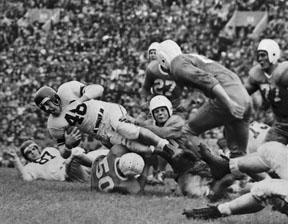 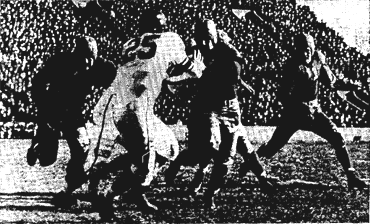
Left: Otto Graham in action against Texas | Right: Wisconsin-Northwestern action
35,000 gathered at Dyche Stadium for one of the most thrilling games anywhere in 1942.
- The visitors started quickly, blocking NU's first punt to start a 37yd drive. Hirsch plunged from the one but fumbled into the EZ where Harder recovered. His PAT made the score 7-0.
- UW began Q2 with an 87yd march. On fourth down from the Wildcat 6, Hirsch tossed a screen pass to Harder for the TD. Pat kicked the point.
- A poor kickoff into the wind went out of bounds on the NU 41. Mixing pass and run, Graham directed a drive that ended with a 2yd TD pass. The score remained 14-7 at halftime.
- NU tallied the only score in Q3. A favorable exchange of punts set up the Wildcats at the UW 32. The home team took advantage of the opportunity, scoring on an 8yd run. However, the PAT sailed wide to preserve the Badgers' one-point lead.
- In Q4, Otto tossed another TD to put the home team ahead 19-14.
- As the clock ticked away, the Badgers drove to the 9 but ran out of downs. However, they stuffed NU and forced a punt to the 36. At that point, Stuhdreher sent his passing HB Bud Seelinger in for Hirsch. On his first snap, Seelinger rolled out to the 15. Harder bulled the ball to the six with less than 30 seconds left. Seelinger then faked to Harder and threw to Mark Hoskins, who reached back and pulled in the ball with one hand as he fell in the EZ. NU blocked the PAT, but Wisconsin led 20-19.
- Three desperate passes by Graham fell incomplete as time ran out.
The Badgers lived to fight another day.
2.5 minute film on Wisconsin's 1942 season
|
|
Not Your Average Season Finale
Game Eight: November 21
Wisconsin hadn't beaten their archrival, the Minnesota Gophers, in the season-ending game since 1932. Legendary coach Bernie Bierman had left after leading UM to its second straight Big Ten championsihp in 1941 to serve in the Marines. Nevertheless, the Gophers had trounced UW 41-6 in Minneapolis in 1941 under new coach George Hauser. Hauser was ably assisted by young Bud Wilkinson, who had been a star under Bierman a few years earlier.
The Gophers had no chance at the Big Ten crown but could end any hope the Badgers had. UW had to win its last game and hope that Michigan defeated Ohio State. The UM game had been sold out for several weeks, and the FBI would dispatch 15 agents to foil ticket scalping. (You would think they had better things to do in wartime.)
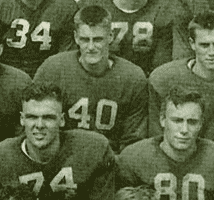
Wisconsin Badgers 1942
#40: HB Elroy Hirsch
#74: T Bob Baumann
#80: E Dave Schreiner
|
With regular QB Jack Wink out with a knee injury, Ashley Anderson took over. On the first play after the kickoff, he called for a pass play. Hirsch hit Schreiner on a short toss, and the All-American E ran down the sidelines for an apparent 69y TD. However, the linesman ruled Schreiner had stepped out at the UM 41. Undaunted, the O drove the rest of the way, with Harder scoring from the 1 after only two and a half minutes had elapsed. Wink went in and held for Harder's successful PAT.
Anderson did not replace Wink on D. Instead, Stuhldreher put Len Calligaro, a FB, into Wink's spot in the secondary. The rules allowed substitutions only at the beginning of a half, after a TD or conversion, or when the ball went out of bounds. So no timeout was needed after the score, but Harry would burn several during the game to make the switch. In fact, he drew several five-yard penalties for too many timeouts late in the game, giving UM first-and-five to start a series. As far as anyone could remember, this was the first time a coach had used this strategy.
UW's second TD resulted from another Hirsch-to-Schreiner pass, this time for 32y to give the Badgers a 14-0 halftime lead. In the second half, Anderson scored the third Badger TD on a QB sneak despite suffering groin and tailbone injuries during the bruising contest. Bill Daley's TD put UM on the board late to make the final score 20-6. Stuhldreher used 25 players for the afternoon, a high total for that era.
|
The Badgers received word that OSU had won 21-7 to clinch the league championship. Still, Stuhldreher told the writers, "I've never been more proud of a bunch of fellows in my whole life than I am this afternoon." The 8-1-1 record was UW's best since 1928's 7-1-1 finish. Since the Big Ten did not allow its teams to compete in bowls, the Badgers' season was over.
Aftermath
Several stars enjoyed the fruits of their outstanding season.
- Schreiner finished third in the nation in receiving yardage, with 16 catches for 350.
- In December, he was named the Big Ten's most valuable player.
- Dave played in the East-West game in San Francisco's Kezar Stadium on January 1, recovering a West fumble and catching a 34y TD pass on the next play to help the East win 13-12.
- Hirsch ranked #6 in the country in rushing with 766 yards. He made the Look magazine All-American team.
- Mark Hoskins was invited to play in the Blue-Gray All-Star Game in Montgomery but declined. As a member of the Army Air Forces Reserve, he feared he would be called up soon and wanted to spend the Christmas break with his girl friend and family.
When school resumed after the holidays, the seniors bore down to graduate in May. However, many underclassmen, figuring they would be called to active duty before the year ended, stopped going to class. The first player to be inducted was an 18yr-old freshman on February 22, 1943. Most of the Air Force men on the team went in a short time later.
On April 8, several senior Badgers were drafted by the NFL.
- Schreiner was selected by the Detroit Lions with the first pick in the second round.
- The Green Bay Packers took Hoskins and four other Badgers.
- T Paul Hirsbrunner went to the Chicago Cardinals while the crosstown Bears took Chicagoan Bob Baumann as well as E Pat Lyons.
- Altogether the NFL drafted 300 players in order to cover for those who would be called to military duty.
Schreiner, Baumann, Seelinger, Hirsbrunner, and George Makris, who had signed with the Marines while in school, were handed weapons almost simultaneously with their sheepskins. Schreiner and Baumann reported to Marine boot camp at Parris Island SC on May 20. Pat Harder, although only a junior, also left school for Marine basic training. He had been so banged up by football that teammates were surprised he passed the physical. The other Badger juniors were told to stay in college and study military-oriented subjects like engineering.
Only one player from the 1942 team, Len Calligaro, would be on the 1943 Badger roster. And Len would enter the military in December. Out of necessity, the NCAA voted to allow freshmen to play varsity ball in 1943. Also, because so many athletes were switching schools depending on the branch of the military they joined, anyone legally enrolled in a school was eligible to play at that school. So a number of key players from the 1942 Badgers who were in the Navy's V-12 program, including Hirsch, Wink, and Bob Hanzlik, along with UM's star back Daley competed in 1943 for Michigan, which administered a 27-0 whipping to UW. Greatly aided by the "Lend-Lease Badgers," UM finished 8-1, losing only to Notre Dame 35-12. Even though the former Badgers were listed as juniors in the program, it was assumed they would not be back for 1944 and were therefore accorded all the honors afforded to seniors: Michigan uniforms, gold footballs, and rings. Hirsch also played basketball and competed in track. The 1943 Badgers went 1-9. Ironically, the only victory was 7-5 at Iowa, the only team to defeat them the previous season.
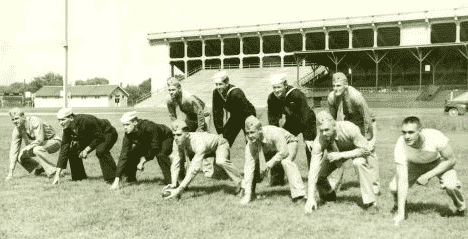
The Lend-Lease Badgers at Michigan in 1943
|
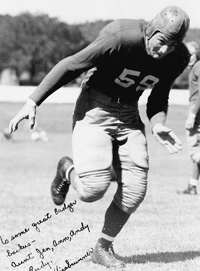
Paul Hirsbrunner
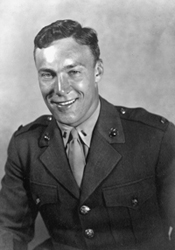
Marine Dave Schreiner
|
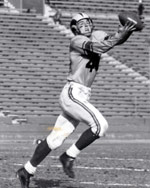
"CrazyLegs" Hirsch with the
Los Angeles Rams |
What happened to the 1942 Badgers in the war?
|
|
|
|
CONTENTS
Part I: Best Talent in Years
Part II: Irish Come Calling
Part III: Buckeye Blues
Part IV: Disappointment in Iowa
Part V: Not Your Average Season Finale
Other Seasons in Time
Notre Dame 1924
Providence Steamroller 1928
Stanford 1940
LSU 1958
Alabama 1966
Football Magazine
Golden Rankings Home
|